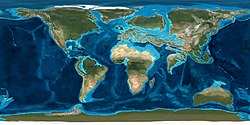| Eocene | |||||||||||||
|---|---|---|---|---|---|---|---|---|---|---|---|---|---|
 Map of the Earth in the early Eocene (50 Ma) | |||||||||||||
| Chronology | |||||||||||||
| |||||||||||||
| Etymology | |||||||||||||
| Name formality | Formal | ||||||||||||
| Usage information | |||||||||||||
| Celestial body | Earth | ||||||||||||
| Regional usage | Global (ICS) | ||||||||||||
| Time scale(s) used | ICS Time Scale | ||||||||||||
| Definition | |||||||||||||
| Chronological unit | Epoch | ||||||||||||
| Stratigraphic unit | Series | ||||||||||||
| Time span formality | Formal | ||||||||||||
| Lower boundary definition | Strong negative anomaly in δ13C values at the PETM[3] | ||||||||||||
| Lower boundary GSSP | Dababiya section, Luxor, Egypt[3] 25°30′00″N 32°31′52″E / 25.5000°N 32.5311°E | ||||||||||||
| Lower GSSP ratified | 2003[3] | ||||||||||||
| Upper boundary definition | LAD of Planktonic Foraminifers Hantkenina and Cribrohantkenina | ||||||||||||
| Upper boundary GSSP | Massignano quarry section, Massignano, Ancona, Italy 43°31′58″N 13°36′04″E / 43.5328°N 13.6011°E | ||||||||||||
| Upper GSSP ratified | 1992[4] | ||||||||||||
The Eocene (IPA: /ˈiːəsiːn, ˈiːoʊ-/ EE-ə-seen, EE-oh-[5][6]) is a geological epoch that lasted from about 56 to 33.9 million years ago (Ma). It is the second epoch of the Paleogene Period in the modern Cenozoic Era. The name Eocene comes from the Ancient Greek Ἠώς (Ēṓs, "Dawn") and καινός (kainós, "new") and refers to the "dawn" of modern ('new') fauna that appeared during the epoch.[7][8]
The Eocene spans the time from the end of the Paleocene Epoch to the beginning of the Oligocene Epoch. The start of the Eocene is marked by a brief period in which the concentration of the carbon isotope 13C in the atmosphere was exceptionally low in comparison with the more common isotope 12C. The average temperature of Earth at the beginning of the Eocene was about 27 degrees Celsius.[9] The end is set at a major extinction event called the Grande Coupure (the "Great Break" in continuity) or the Eocene–Oligocene extinction event, which may be related to the impact of one or more large bolides in Siberia and in what is now Chesapeake Bay. As with other geologic periods, the strata that define the start and end of the epoch are well identified,[10] though their exact dates are slightly uncertain.
- ^ Zachos, J. C.; Kump, L. R. (2005). "Carbon cycle feedbacks and the initiation of Antarctic glaciation in the earliest Oligocene". Global and Planetary Change. 47 (1): 51–66. Bibcode:2005GPC....47...51Z. doi:10.1016/j.gloplacha.2005.01.001.
- ^ "International Chronostratigraphic Chart" (PDF). International Commission on Stratigraphy.
- ^ a b c Aubry, Marie-Pierre; Ouda, Khaled; Dupuis, Christian; William A. Berggren; John A. Van Couvering; Working Group on the Paleocene/Eocene Boundary (2007). "The Global Standard Stratotype-section and Point (GSSP) for the base of the Eocene Series in the Dababiya section (Egypt)" (PDF). Episodes. 30 (4): 271–286. doi:10.18814/epiiugs/2007/v30i4/003.
- ^ Silva, Isabella; Jenkins, D. (September 1993). "Decision on the Eocene-Oligocene boundary stratotype" (PDF). Episodes. 16 (3): 379–382. doi:10.18814/epiiugs/1993/v16i3/002. Retrieved 13 December 2020.
- ^ Jones, Daniel (2003) [1917], Peter Roach; James Hartmann; Jane Setter (eds.), English Pronouncing Dictionary, Cambridge: Cambridge University Press, ISBN 3-12-539683-2
- ^ "Eocene". Merriam-Webster.com Dictionary. Merriam-Webster.
- ^ See:
- Letter from William Whewell to Charles Lyell dated 31 January 1831 in: Todhunter, Isaac, ed. (1876). William Whewell, D. D., Master of Trinity College, Cambridge: An account of his writings with selections from his literary and scientific correspondence. Vol. 2. London, England: Macmillan and Co. p. 111.
- Lyell, Charles (1833). Principles of Geology, …. Vol. 3. London, England: John Murray. p. 55. From p. 55: "The period next antecedent we shall call Eocene, from ήως, aurora, and χαινος, recens, because the extremely small proportion of living species contained in these strata, indicates what may be considered the first commencement, or dawn, of the existing state of the animate creation."
- ^ "Eocene". Online Etymology Dictionary.
- ^ Burke, K. D.; Williams, J. W.; Chandler, M. A.; Haywood, A. M.; Lunt, D. J.; Otto-Bliesner, B. L. (2018). "Pliocene and Eocene provide best analogs for near-future climates". Proceedings of the National Academy of Sciences. 115 (52): 13288–13293. Bibcode:2018PNAS..11513288B. doi:10.1073/pnas.1809600115. PMID 30530685.
- ^ The extinction of the Hantkeninidae, a planktonic family of foraminifera became generally accepted as marking the Eocene-Oligocene boundary; in 1998 Massignano in Umbria, central Italy, was designated the Global Boundary Stratotype Section and Point (GSSP).